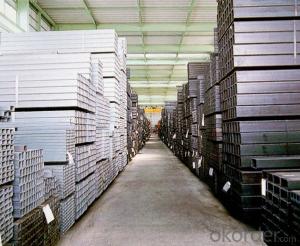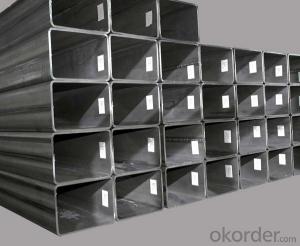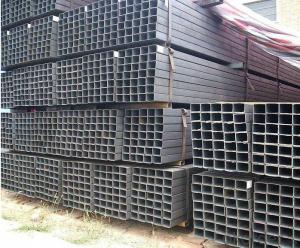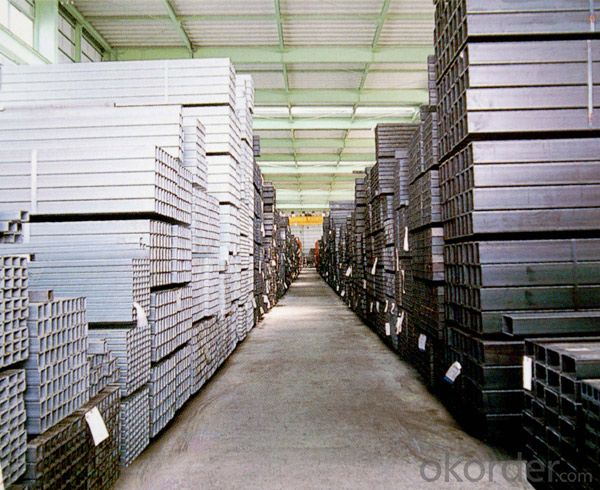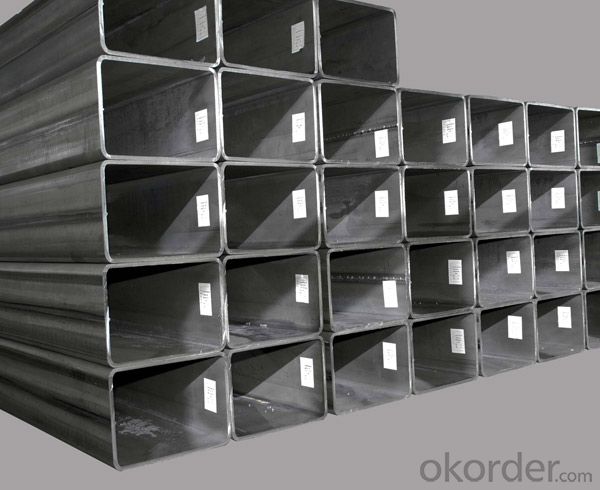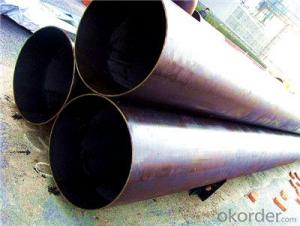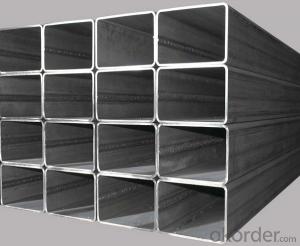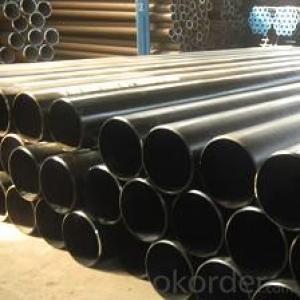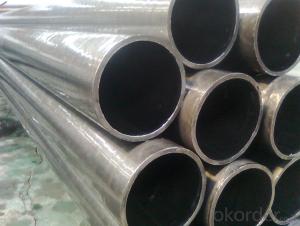Hollow Section-Square Pipes With High Quality
- Loading Port:
- Tianjin
- Payment Terms:
- TT OR LC
- Min Order Qty:
- 25 m.t.
- Supply Capability:
- 10000 m.t./month
OKorder Service Pledge
OKorder Financial Service
You Might Also Like
Carbon ERW Welded Pipes-Square Tube And Pipe For Furniture ASTM A53 Hollow Section Details:
| Minimum Order Quantity: | 50MT | Unit: | m.t. | Loading Port: | China Main Port |
| Supply Ability: | based on order | Payment Terms: | TT or L/C |
Product Description:
1. Specification of ERW Welded Pipes-Square Tube and Pipe for Furniture ASTM A53 Hollow Section
1) Application: Greenhouse pipes, scaffolding pipes, transportation the ocean oil and gas, mechanical tube of ocean platform, power station, chemical industry and building, construction foundation piles, steel structure building, for low-pressur fluid service, steel structure bridges etc.
2) Standard: ASTM A53, BS1387, GB/T9711, GB/T39013
3) Steel Grade: Q195/Q215/Q235/Q345
2. Sizes of ERW Welded Pipe- Square Tube and Pipe for Furniture ASTM A53 Hollow Section
Outer Diameter: 1/2"x1/2"-16"x16''
Thickness:4.0-12.75mm
Length: As costumer's requirement
2. Packing & Delivery
Packing Detail: Packing in bundle with steel strips;with seaworthy package at the end; could be done with your requirement
Delivery Time: Within 30 Days after the reception of prepayment or L/C
3. Data Sheet
Standard: ASTM A53
Mechanical Properties
Standard | Grade | (MPa) | (MPa) |
Yield strength | Tensile Strength | ||
ASTM A53M | A | 205 | 330 |
B | 240 | 415 |
Chemical Composition(%)
Standard | Grade | C | Mn | P | S | V | Ni | Cu | Cr | Mo |
Max | Max | Max | Max | Max | Max | Max | Max | Max | ||
ASTM A53M | A | 0.25 | 0.95 | 0.05 | 0.045 | 0.08 | 0.4 | 0.5 | 0.4 | 0.15 |
B | 0.30 | 1.20 | 0.05 | 0.045 | 0.08 | 0.4 | 0.5 | 0.4 | 0.15 |
- Q: How are steel pipes used in the manufacturing of wastewater treatment systems?
- Steel pipes are used in the manufacturing of wastewater treatment systems for various purposes such as carrying and transporting wastewater, providing structural support to the system, and facilitating the flow of water and chemicals throughout the treatment process.
- Q: How are steel pipes used in airport infrastructure?
- Steel pipes are widely used in airport infrastructure for various purposes. They are used for constructing the framework of airport terminals, hangars, and other buildings. Steel pipes are also used for the installation of HVAC systems, electrical wiring, and plumbing in airport facilities. Additionally, steel pipes are used for the construction of runways, taxiways, and aprons, providing a strong and durable foundation for aircraft operations.
- Q: What are the different types of coatings applied to steel pipes?
- There are several types of coatings applied to steel pipes, including epoxy coatings, fusion-bonded epoxy (FBE) coatings, polyethylene (PE) coatings, polyurethane (PU) coatings, and zinc coatings.
- Q: What are the challenges faced in transporting steel pipes?
- Some of the challenges faced in transporting steel pipes include their large size and weight, which can make them difficult to handle and transport. Additionally, their shape can make it challenging to secure them properly during transportation to prevent damage or accidents. The corrosive nature of steel pipes can also pose a challenge, as special precautions need to be taken to protect them from rust or other forms of damage during transportation. Finally, the cost of transportation can be a challenge, as steel pipes often require specialized equipment and vehicles, which can be expensive to rent or purchase.
- Q: How are steel pipes protected against external damage?
- Steel pipes are protected against external damage through various methods such as coatings, wraps, and cathodic protection. These protective measures help prevent corrosion, abrasion, and other forms of external damage, ensuring the durability and longevity of the pipes.
- Q: Are steel pipes suitable for transporting gas?
- Yes, steel pipes are suitable for transporting gas. Steel pipes are known for their durability, strength, and resistance to corrosion, making them a reliable choice for transporting various types of gases, including natural gas, oil, and other flammable substances. Additionally, steel pipes can handle high pressure and temperature conditions, ensuring the safe and efficient transportation of gas over long distances.
- Q: What is the difference between steel pipes and aluminum pipes?
- The main difference between steel pipes and aluminum pipes is the material they are made of. Steel pipes are made from steel, which is a strong and durable metal. Aluminum pipes, on the other hand, are made from aluminum, which is a lightweight and corrosion-resistant metal. Steel pipes are typically used for applications that require high strength and durability, such as in construction and plumbing. Aluminum pipes, on the other hand, are commonly used in industries where weight is a concern, such as aerospace and automotive industries.
- Q: What are the safety precautions when working with steel pipes?
- When working with steel pipes, some important safety precautions to follow include wearing appropriate personal protective equipment (PPE) such as gloves, safety glasses, and steel-toed boots to protect against potential injuries. Additionally, it is essential to ensure proper ventilation in the work area to prevent the accumulation of hazardous fumes or gases. Using the correct tools and equipment, such as pipe wrenches and clamps, and following proper lifting techniques are crucial to avoid strains or back injuries. Regular inspection and maintenance of the pipes and equipment are also necessary to prevent any potential accidents. Lastly, it is important to receive proper training and follow established safety procedures to minimize risks and promote a safe working environment.
- Q: Do steel pipes require maintenance?
- Yes, steel pipes do require maintenance. While steel pipes are durable and long-lasting, they can still be subject to wear and tear over time. Regular maintenance is important to ensure their optimal performance and prolong their lifespan. One important aspect of maintenance is inspecting the pipes for any signs of damage or corrosion. Steel pipes can be vulnerable to rust and corrosion, especially in environments with high humidity or exposure to water. Regular inspections allow for early detection of any issues, which can prevent more significant damage and costly repairs in the future. Another aspect of maintenance is cleaning the pipes. Over time, steel pipes can accumulate debris, sediment, or mineral deposits. These build-ups can restrict the flow of fluids or affect the quality of the transported materials. Regular cleaning helps to remove these obstructions and maintain the efficiency of the pipes. Depending on the application, steel pipes may also require periodic lubrication or coating. This helps to reduce friction, prevent corrosion, and enhance the pipes' durability. Lubricants and coatings can be applied during maintenance to ensure the pipes continue to function smoothly and resist corrosion. Overall, regular maintenance of steel pipes is essential to maximize their performance, prevent damage, and prolong their lifespan. By investing time and effort in maintenance, potential issues can be identified and addressed early on, ultimately saving time and money in the long run.
- Q: What are the different methods of lining steel pipes?
- There exist various techniques for lining steel pipes, each possessing distinct advantages and applications. Some popular methods comprise: 1. Cement Mortar Lining: This technique entails the application of a cement mortar layer onto the inner surface of the steel pipe. Cement mortar offers outstanding protection against corrosion and grants smoothness to the pipe, consequently diminishing friction and enhancing flow rates. It finds common usage in water supply systems and sewage treatment plants. 2. Polyethylene (PE) Lining: PE lining necessitates the insertion of a polyethylene tube into the steel pipe. Typically, the tube is heat fused or mechanically connected to the steel pipe, resulting in a seamless and corrosion-resistant lining. PE lining is commonly employed in gas transmission and distribution pipelines. 3. Epoxy Lining: Epoxy lining involves the application of an epoxy resin onto the inner surface of the steel pipe. Epoxy coatings exhibit exceptional resistance to corrosion, abrasion, and chemicals, thereby making them suitable for a variety of applications such as oil and gas pipelines, water treatment, and industrial processes. 4. Trenchless Pipe Lining: This method serves to rehabilitate existing steel pipes without the requirement of excavation. It encompasses the insertion of a liner or resin-coated fabric into the existing pipe, which is subsequently inflated and cured to form a new lining. Trenchless pipe lining is commonly utilized for sewer and water main rehabilitation. 5. Polyurethane (PU) Lining: PU lining involves the spraying or pouring of a polyurethane coating onto the inner surface of the steel pipe. Polyurethane linings deliver excellent resistance to abrasion, impact, and chemicals, thereby suiting applications in mining, slurry pipelines, and wastewater treatment. These represent merely a few of the numerous methods accessible for lining steel pipes. The selection of a lining approach is contingent upon factors such as the intended application, the environment, and the desired level of corrosion resistance and durability.
Send your message to us
Hollow Section-Square Pipes With High Quality
- Loading Port:
- Tianjin
- Payment Terms:
- TT OR LC
- Min Order Qty:
- 25 m.t.
- Supply Capability:
- 10000 m.t./month
OKorder Service Pledge
OKorder Financial Service
Similar products
Hot products
Hot Searches
Related keywords
